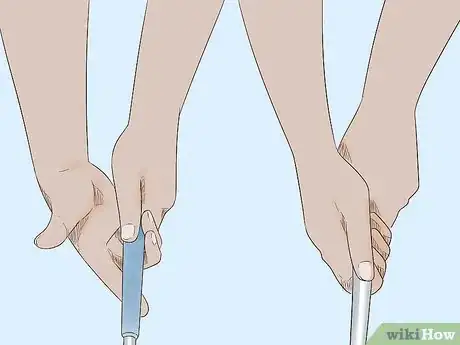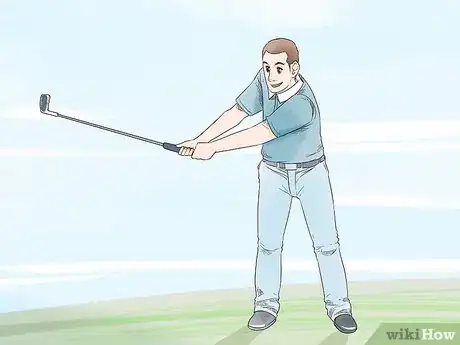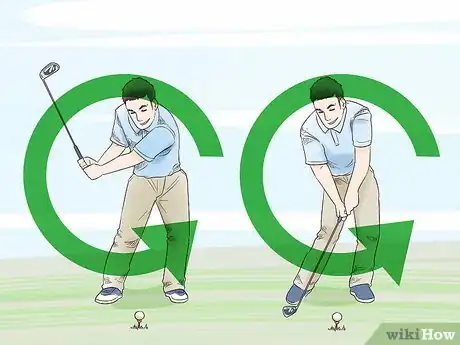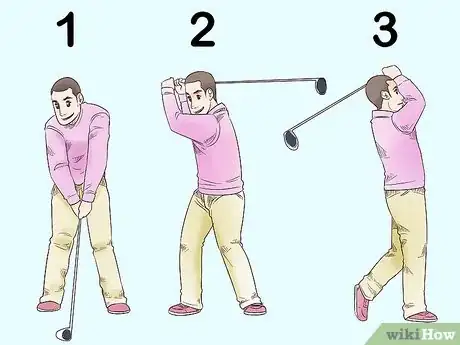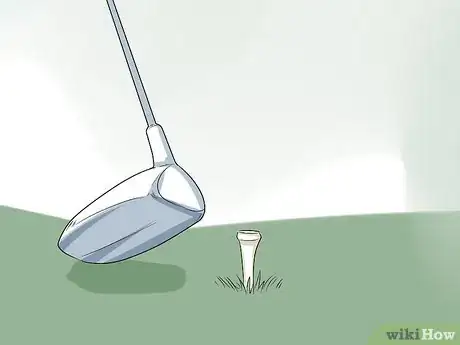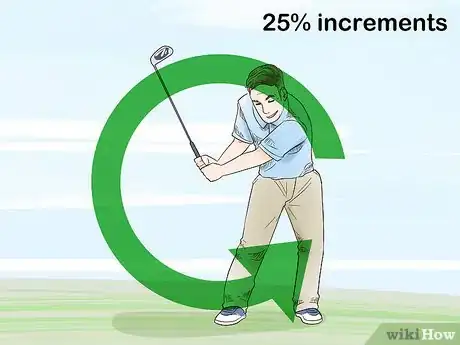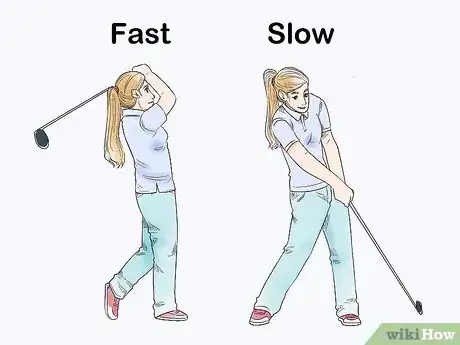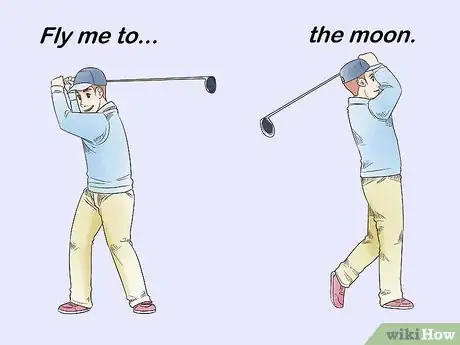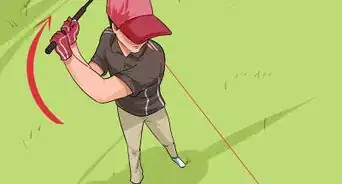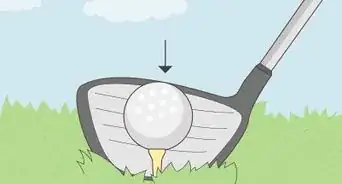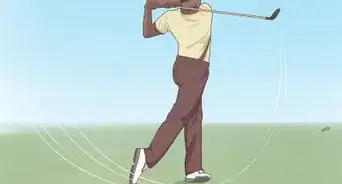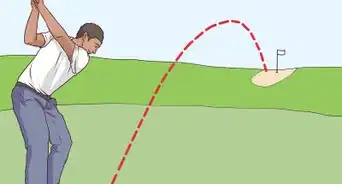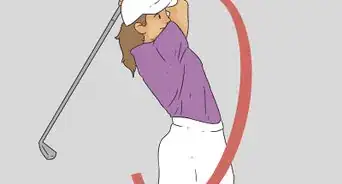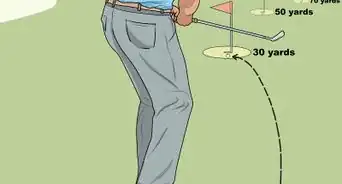This article was co-authored by Michael Metz. Michael Metz is a Golf Instructor and the Director of Instruction at Simi Hills Golf Course. With more than 15 years of experience, Michael is adept at coaching all facets of Golf. Mike uses technology, such as Flightscope, V1 Swing Suite, Blast Motion, and BodiTrak pressure mapping, to provide advanced golf training with quick results.
There are 8 references cited in this article, which can be found at the bottom of the page.
This article has been viewed 47,699 times.
In golf, tempo refers to the amount of time between the start of your takeaway and the end of your follow through. While it may seem inconsequential, proper tempo can improve your game tremendously and mark the difference between a duff and a hole-in-one.
Steps
Getting the Motions Down
-
1Make each action deliberate to keep yourself relaxed. One of the most common causes of poor golf tempo is tension. If you’re nervous before hitting the ball, or if you don’t think you can make the shot, there’s a good chance your tempo will be thrown off. To counter your nerves, try to calm yourself down before addressing the ball. Make each action deliberate, and remind yourself that:[1]
- You are a great golfer and are more than capable of hitting the ball.
- Nerves are the only thing standing between you and success, not talent.
-
2Grip the club firmly, but keep your wrists loose. While getting ready to swing, keep a strong, firm grasp on your club. Doing so will give you the control and power necessary to hit the ball successfully. However, at the same time, keep your wrists loose, relaxed, and maneuverable. This will allow you to swing the club less like a stick and more like a whip, something that, once you get your tempo down, will lead to a speed increase.[2]Advertisement
-
3Perform a slow takeaway. Start your takeaway by turning your non-dominant shoulder away from the ball. Do this as smoothly as you can, making sure each movement is deliberate. The speed of your takeaway will set the tempo for the entire swing, so take it slowly and, if the backswing doesn’t feel right, start over.[3]
-
4Pull your club as far back as possible. When performing your backswing, it’s important to pull your club as far away from the ball as possible, otherwise you may not gain the strength necessary to hit it properly. Additionally, an improper backswing will throw off your overall tempo, making it more difficult to connect with the ball.[4]
- When done properly, your backswing should end with the club raised far above your head, held in place by barely-bent arms.
-
5Start your downswing at the same pace as your backswing. After completing your backswing, you can either start your downswing immediately or pause for a moment to concentrate. However, once you’re ready to begin the downswing, start it at the same speed as your backswing. As you close in on the ball, let your pace accelerate naturally and keep the momentum going until you complete your follow through.[5]
Working on Your Swing
-
1Aim for a downswing that is 3 times faster than your backswing. From Tiger Woods to Arnold Palmer, just about every golf master has a 3:1 swing tempo, meaning their backswing takes 3 times longer to complete than their downswing.[6] While practicing, ask a friend to time both portions of your swing to see how you stack up.[7]
- If your downswing is too fast, try slowing down your takeaway to change the pace of the shot.
- If your downswing is too slow, make sure your posture is correct and not causing unnecessary drag.
-
2Practice your shots with an empty tee. When working on your tempo, practicing with real balls can quickly psyche you out, especially if they never go as far as you want. So you can focus exclusively on the speed of your swing, practice with nothing but an empty tee. With no ball to worry about, you can think more about how long a shot takes and whether or not it feels right.[8]
-
3Alter your swing speed in 25% increments. It can be difficult to change your current golf tempo, especially if you’re an experienced player with a lot of built in muscle memory. However, you don’t need to do it overnight. Instead, try to slow down or speed up your swing by about 25% at a time. Practice at your new pace until you get used to it, then change it by another 25%. Keep doing this until you reach the 3:1 swing ratio.[9]
-
4Keep your speed consistent between shots. In many cases, tempo problems stem from inconsistent swings, meaning the golfer changes their speed between holes, clubs, or even individual shots. Having a variable tempo means that the rhythm of each swing is random, making it difficult to control the power of your shots or predict what each swing will accomplish. Do your best to be consistent from 1 shot to the next, that way you can enjoy the benefits of proper golfing tempo.[10]
- With the exception of the putter, you can use the same tempo for every type of club.
-
5Count in your head to better time your swing. Until your tempo becomes second nature, keeping a mental timer can help you make your shots more consistent while ensuring they’re done at a proper speed. Though you can choose any pattern you want, the 1-2-3 count used for waltzing meshes well with golf tempo, the first 2 beats lining up with the backswing and the third beat lining up with the downswing. In addition, you can try and time out your swings using songs like:[11]
- Edelweiss from Fiddler on the Roof, where the backswing lines up with “E-del” and the downswing lands on “weiss.”
- Fly Me To The Moon by Frank Sinatra, where the backswing lines up with “Fly me to” and the downswing lands on “the moon.”
- Fallin’ by Alicia Keys, where the backswing lines up with “I keep on” and the downswing lands on “fallin’.”
Expert Q&A
-
QuestionHow do you measure swing tempo?
 Michael MetzMichael Metz is a Golf Instructor and the Director of Instruction at Simi Hills Golf Course. With more than 15 years of experience, Michael is adept at coaching all facets of Golf. Mike uses technology, such as Flightscope, V1 Swing Suite, Blast Motion, and BodiTrak pressure mapping, to provide advanced golf training with quick results.
Michael MetzMichael Metz is a Golf Instructor and the Director of Instruction at Simi Hills Golf Course. With more than 15 years of experience, Michael is adept at coaching all facets of Golf. Mike uses technology, such as Flightscope, V1 Swing Suite, Blast Motion, and BodiTrak pressure mapping, to provide advanced golf training with quick results.
Golf Instructor The best way to do it is to use a digital metronome and burn that into your brain. It is a life changer for golf. With the metronome, you can find out if somebody is a two to one swinger or three to one swinger — a four to one swinger is a little unusual, though.
The best way to do it is to use a digital metronome and burn that into your brain. It is a life changer for golf. With the metronome, you can find out if somebody is a two to one swinger or three to one swinger — a four to one swinger is a little unusual, though.
References
- ↑ http://golftips.golfweek.com/proper-tempo-golf-swing-20325.html
- ↑ https://www.golfdigest.com/story/rob-akins-swing-tempo
- ↑ http://golftips.golfweek.com/proper-tempo-golf-swing-20325.html
- ↑ https://www.golfdigest.com/story/watson-top-swing
- ↑ http://golftips.golfweek.com/proper-tempo-golf-swing-20325.html
- ↑ Michael Metz. Golf Instructor. Expert Interview. 24 February 2022.
- ↑ https://www.tourtempo.com/GOLF-WORLD-Magazine-TOUR-TEMPO.pdf
- ↑ https://www.golftipsmag.com/instruction/quick-tips/tempo-is-tops/
- ↑ Michael Metz. Golf Instructor. Expert Interview. 24 February 2022.
About This Article
To maintain a good tempo during your swing, approach the ball with confidence and try to stay relaxed. Hold your club with a firm grip for power and loose wrists for speed, then start your takeaway. As you perform your backswing, maintain a slow, constant speed until you reach the peak of your movement. When you’re ready, begin your downswing at the same pace as your backswing and let the club pick up speed naturally. For tips on practicing and altering your golf swing tempo, read on!

